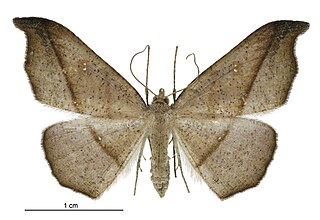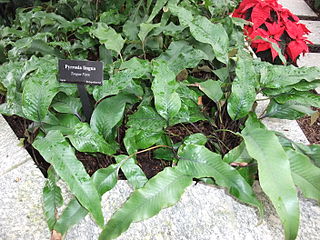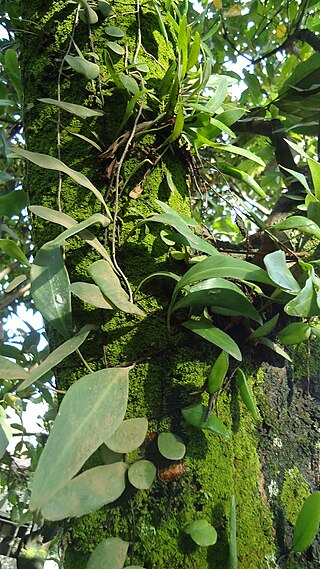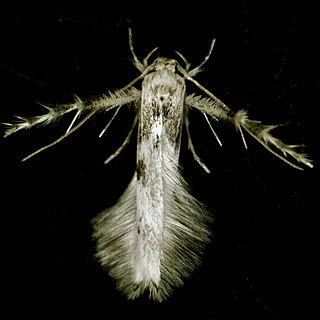
Spearmint, a species of mint (mentha) scientifically classified as Mentha spicata (,) also known as garden mint, common mint, lamb mint and mackerel mint, is native to Europe and southern temperate Asia, extending from Ireland in the west to southern China in the east. It is naturalized in many other temperate parts of the world, including northern and southern Africa, North America, and South America. It is used as a flavouring in food and herbal teas. The aromatic oil, called oil of spearmint, is also used as a flavoring and sometimes as a scent.

Polypodiaceae is a family of ferns. In the Pteridophyte Phylogeny Group classification of 2016, the family includes around 65 genera and an estimated 1,650 species and is placed in the order Polypodiales, suborder Polypodiineae. A broader circumscription has also been used, in which the family includes other families kept separate in PPG I. Nearly all species are epiphytes, but some are terrestrial.

Eurycoma longifolia is a flowering plant in the family Simaroubaceae. It is native to Indochina and Indonesia, but has also been found in the Philippines. The plant is a medium-sized slender shrub that can reach 10 m (33 ft) in height, and is often unbranched. The root of the plant has been used in folk medicine of the South East Asian region, and in modern times has common use as supplements, as well as food and drink additives.
The greater Brisbane area of Queensland Australia, has many species of indigenous flora. This article links the flora to its geography with:

Madhuca longifolia is an Indian tropical tree found largely in the central, southern, north Indian plains and forests, Nepal, Myanmar and Sri Lanka. It is commonly known as madhūka, madkam, mahuwa, Butter Tree, mahua, mahwa, mohulo, Iluppai, Mee or vippa chettu. It is a fast-growing tree that grows to approximately 20 meters in height, possesses evergreen or semi-evergreen foliage, and belongs to the family Sapotaceae. It is adaptable to arid environments, being a prominent tree in tropical mixed deciduous forests in India in the states of Odisha, Chhattisgarh, Jharkhand, Uttar Pradesh, Bihar, Maharashtra, Andhra Pradesh, Madhya Pradesh, Kerala, Gujarat, West Bengal and Tamil Nadu.

Lomandra longifolia, commonly known as spiny-head mat-rush, spiky-headed mat-rush or basket grass, is a perennial, rhizomatous herb found throughout eastern Australia. The leaves are 40 cm to 80 cm long, and generally have a leaf of about 8 mm to 12 mm wide. It grows in a variety of soil types and is frost, heat and drought tolerant. Labillardiere described Lomandra longifolia from a specimen collected in Tasmania.

Sarisa is a monotypic moth genus in the family Geometridae and was first described by David Stephen Fletcher in 1979. The genus contains only one species, Sarisa muriferata, the hook-tip fern looper, which is endemic to New Zealand and surrounding islands. This species was described by Francis Walker in 1862. It is widespread in the North and South Islands, and has been recorded from Stewart Island, Big South Cape Island, the Chatham Islands and the Auckland Islands.

Pyrrosia lingua is a species of epiphytic fern in the family Polypodiaceae. It occurs through China and Southeast Asia and into Japan and Taiwan. Pyrrosia lingua is grown as a cultivated plant, and multiple named cultivars have been developed.

Pyrrosia rupestris known as the rock felt fern is a common fern of eastern Australia. Occurring as an epiphyte or lithophyte in areas of part shade and high moisture. Usually found in rainforest or moist eucalyptus forest. Often seen on rainforest trees, quite high above the ground. However, it grows as far west at the more arid Warrumbungle National Park. In drought it shrinks and becomes desiccated. With rain or mist the fern recovers well.

Platycerioideae is a small subfamily of the fern family Polypodiaceae in the Pteridophyte Phylogeny Group classification of 2016 (PPG I). The subfamily is also treated as the tribe Platycerieae within a very broadly defined family Polypodiaceae sensu lato.
Pteris longifolia, the longleaf brake is a species of fern in the Pteridoideae subfamily of the Pteridaceae.

Pyrrosia eleagnifolia, commonly known as the leather-leaf fern, or ota in Māori, is a climbing fern endemic to New Zealand. P. eleagnifolia has thick, fleshy rounded leaves, and grows both on the ground and as an epiphyte.

Pyrrosia is a genus of about 100 fern species in the polypod family, Polypodiaceae. Like other species in Polypodiaceae, the species of Pyrrosia are generally epiphytic on trees or rocks, a few species are terrestrial. The Latin name of Pyrrosia comes from the Greek pyrrhos (red), which refers to its leaves that are red due to the sporangia.

Leather-leaf fern is a common name for several ferns and may refer to:

Calicotis crucifera, the leather-leaf spore-eater, is a moth of the Stathmopodidae family. It is found in New Zealand and Australia.

Pajanelia, sometimes known in English as tender wild jack or pajanelia, in Malayalam as azhantha or pajneli, in Kannada as alangi and in Tamil as aranthal, is a monotypic genus of evergreen or briefly deciduous flowering tree in the family Bignoniaceae which contains a single species, Pajanelia longifolia.
Paragramma is a genus of ferns in the family Polypodiaceae, subfamily Microsoroideae according to the Pteridophyte Phylogeny Group classification of 2016 (PPG I). There is a single species, Paragramma longifolia. Other sources do not accept the genus, submerging it into Lepisorus, with Paragramma longifolia becoming Lepisorus longifolius(Blume) Holttum. A molecular phylogenetic study in 2019 showed that Lepisorus longifolius was sister to all the remaining species of Lepisorus, which formed a clade.

Lepisorus is a genus of ferns in the family Polypodiaceae, subfamily Microsoroideae, according to the Pteridophyte Phylogeny Group classification of 2016 (PPG I).

Pyrrosia stigmosa is an epiphytic fern in the family Polypodiaceae. It is native to China, Tibet, Indochina, Peninsular Malaysia, Sumatra, the Lesser Sunda Islands, Sulawesi, and New Guinea
















